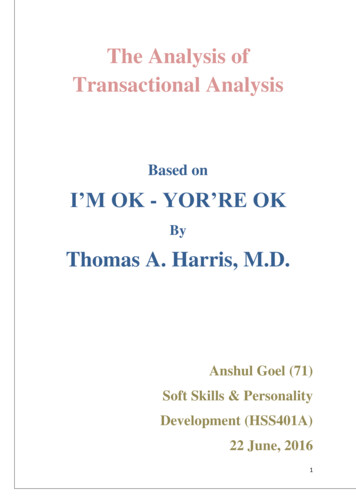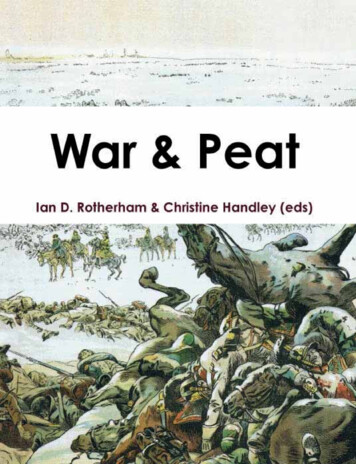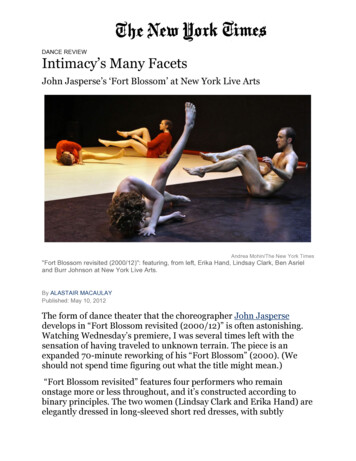
Transcription
The Analysis ofTransactional AnalysisBased onI’M OK - YOR’RE OKByThomas A. Harris, M.D.Anshul Goel (71)Soft Skills & PersonalityDevelopment (HSS401A)22 June, 20161
ContentsWhy This Book .3Transactional Analysis 4Parent, Adult, Child 5The Four Life Positions .11We Can Change .16Analysing the Transaction .18How to Stay in Adult .31My Analysis. .32References .342
Why This Book?When it came to choosing a book for my project, I was literally dumb.Each book I went through was too good to be left. So, what led me todecide this book? As a part of the course curriculum, we wereacquainted with the concept of Win-Win, Synergise and SelfActualisation. Though I was able to digest self-actualisation, it washard to agree to the former two. While glancing through this book, Irealised that this book offers a new perspective to all these, which wasquite apt to me. So, there it is.There is a legend about a wise man who was sitting outside hisvillage. A traveller came up and asked him, “What kind of peoplelive in this village, because I am looking to move from my presentone?” The wise man asked, “What kind of people lives where youwant to move from?” The man said, “They are mean, cruel, andrude.” The wise man replied, “The same kind of people lives inthis village too.” After some time another traveller came by andasked the same question and the wise man asked him, “What kindof people live where you want to move from?” And the travellerreplied, “The people are very kind, courteous, polite and good.”The wise man said, “You will find the same kind of people heretoo.”[You Can Win, Shiv Khera]The essence of this book cannot be mimicked in just a single tale orquote, but the above one is very close to that. The book cannot becalled a personality development book. It would be severe injustice onits part to bluntly reduce it to a self-help book which works onsuperficial elements or give some nail-biting tic-tacks. It offers acomplete vision and way of life, if not equivalent to Holy Bible butnone less than its contemporary.3
We have specialists - doctors, scientist, astronauts, psychologists andwe have common masses, both of which are cut apart from each otherdue to technical barriers. The fundamental contribution of SigmundFreud, the concept of Id, Ego and Superego, is unquestionably ofparamount importance. But, do common masses are able tounderstand these technical jargons, and even if it is understood, doesit offer a solution to their problem? The answer to this dilemma isprovided by the author, Thomas A. Harris, with the concept ofTransactional Analysis around which the whole book revolves.Apart from this, the book offers answers to many interestingquestions: When is a baby psychologically born? Is there an ‘Adult’ in an infant? When does this ‘Adult’ come into picture? What was the clash between Adler and Freud? What are the games in ‘Games People Play’ by Eric Berne? Arethey ‘Good’?Transactional AnalysisThe concept of Transactional Analysis was originated by Eric Berne[author of the best seller, Games People Play]. He defined this basicscientific unit:“The unit of social intercourse is called a transaction. If two or morepeople encounter each other . sooner or later one of them will speak,or give some other indication of acknowledging the presence of the4
others. This is called the transactional stimulus. Another person willthen says or do something which is in some way related to thestimulus, and that is called the transactional response.”Transactional Analysis is the way of analysing this transaction anddetermine which part of multiple nature human is activated – ‘Parent’,‘Adult’ or ‘Child’. (The meaning of ‘Parent’, ‘Adult’ and ‘Child’ isdifferent from their meaning in general and everywhere in thisproject, these terms start with capital letter to signify this.) It involvesgetting information from the words said. But an acute problem arises,the words people say are biased according to their behaviour, we say“He’s an obsessive fielder” when talking about a fielder in baseball.Though the problem persist, still the Transactional Analysis claims tohave found some of the regularities, a new language of psychology,language of Parent, Adult, Child, Ok, Not Ok, Games, which holdsgreat promises by getting closest to the secret of human behaviourthan ever before.Parent, Adult, ChildWe often find instantaneous changes in behaviour of people. Thereare changes in the facial expressions, the posture, body language, toneand gestures. These abrupt changes are observed in people of all agegroups: the little child face gets flushed on not able to make a toy, theface of father ‘turns to stone’ when his daughter/son disagrees withhim. We all have experienced these things at least once in ourlifetime, the sudden changes from one state to next.Berne figured these states and classified these into Parent, Adult andChild. An important point to note is that these are not just conceptslike Id, Ego or Superego but are psychological realities, and all thesestates exist in each human being.5
The ParentIt is the recording of all events, rules, laws and data imposed on thechild in first five years of life, without any modification as he isunable to construct meaning out of the words. The laws told arerecorded as truths whether they these are actually good or bad. Itbecomes important for a child to please and obey her/his parents.These children suffer from a strange condition – the insecurity of thetwo feet tall from the six feet tall person. Though the Parent mayseem as largely negative, but it is also the lifesaving, the knowledgethat species passes over the generations for survival. The followingexcerpt from the book will pinpoint the fact:In the Parent is the recording, 'Don't touch that knife!' It is athunderous directive. The threat to the little person, as he sees it, isthat his mother will spank him or otherwise show disapproval. Thegreater threat is that he can cut himself and bleed to death. He cannotperceive this. He does not have adequate data. The recording ofparental dictates, then, is an indispensable aid to survival, in both thephysical and the social sense.A characteristic problem with the Parent is the fidelity of therecordings with inconsistency. When parents say one thing and doanother, for example, “Don’t lie” but tell lies, “Smoking is bad” butsmokes, “Follow religious ethics” but don’t follow them. Other thingis that if the parents are not harmonious, that is, there are recordingsof ‘good’ mother and ‘bad’ father or vice-versa, the Parent as a wholeis weakened because the data from one parent is not in accordancewith other and causes anxiety. Then, the role of Parent is notinfluential.The Parent data also comprises of ‘how to’ - how to hit a nail, how toeat soup, how to blow your nose, how to shake hands, or how to foldthe bath towels. These are learnt by watching or imitating the parents6
and reside in Parent (perfected by Adult). The sources of Parent arenot only physical parents, but any external situation in which the littleperson feels himself to be dependent to the extent that he is not free toquestion or explore the data stored in Parent. Thus, Televisionprogrammes and elder siblings are also the sources.Figure 1. The ParentThe ChildThe Child is the storehouse of emotions, responses of the little childto what s/he hears, sees and feels. Whenever the Child is hooked on,the person feels the same emotions again, which were originallyproduced in her/him and the same interpretations of right or wrongwhich were experienced at the first place. Since the little person hasno vocabulary during the years of gaining all these emotions, most ofher/his store comprises of feelings as reactions.Many a times the demand for approval of parents is contradicted dueto certain acts of little child, the urges to empty her/his bowels ad lib,to bang, to crush the things. The child is not able to made connexion7
between cause and effects which leads to the negative feelings.Accumulation of these feelings over a period of time comes out asNot Ok feelings, ‘I am not Ok - You are OK’. This is the situation ofchildhood and not the intentions of parents. This is recordedpermanently in mind and can’t be erased.But, the Child is a store of positive things too. The Child constitutescreativity, curiosity, desire to explore, and also the record of peakmoments, the experiences of ‘first in the lifetime’. These things leadto Ok condition in Child but still the Not Ok feeling dominates.Figure 2. The ChildTalking about the age by which both the Child and Parent stoprecording, the author believes that by the age of five or going tokindergarten (the first independent social experience), s/he has gotacquainted to all the feelings and emotions. So, it can be safelyregarded as the finishing of the recording, and a predominant8
expression of Parent in the early years. As Brian Tracy said,“Whatever is expressed is impressed”.The AdultIn the start, two questions were stated – “Is there an ‘Adult’ in aninfant?” and “When does this ‘Adult’ come into picture?” . Theanswer to these questions is present in this section. By the age of tenmonths, a little child gets the power of locomotion. Now, he has gotthe ability to change the things and choose his own responses. The tenmonths old realises that he has his own awareness and thoughtprocess. This “self-actualisation” is the beginning of the Adult.Remember, one of the most self-actualised people is children. Theyare able to accept their environment as it, their spontaneity andsimplicity, their problem centric approach, peak experiences, allpointing to self-actualisation. However, some traits are not evendeveloped to be talked about. So, the answer to the first question isyes, and Adult comes into picture as early as ten months.With the advent of Adult, child starts to test the validity of the data ofParent and Child and the result of this goes to this is stored as data ofAdult. As said by author, “Through the Adult the little person canbegin to tell the difference between life as it was taught anddemonstrated to him (Parent), life as he felt it or wished it orfantasized it (Child), and life as he figures it out by himself (Adult).”But, it is important to point out that the verification of Parent datacannot erase the Not Ok recordings in the Child. ‘We cannot erase therecordings, but we can choose to turn them off.’9
Figure 3. The updating function of the Adult through reality testingThe Adult within the Adult in figure 3 refers to the updated reality,for example, the evidence once states that space travel is impossible,but now it is a reality. Apart from the task of validating previous dataand feelings, and gathering new data, another function of Adult is‘probability estimating’ – estimating the outcomes in varioussituations – either to eat spinach or go without ice-cream. Thisprocess is quite slow in the children owing to the lack of knowledgeof forthcoming incidents. But, if the Adult is alert to the possibility ofthe trouble, through probability estimating, it can also devise solutionsto meet the trouble if and when it comes. This is the reason why signboards are installed by Highway Authorities to let your Adult know ofthe certain troubles possible.The concept of creativity goes hand-in-hand with Child and Adult.The Child provides the ‘want to’ and the Adult provides the ‘how to’.I recall a recent example from class. When sir asked the possiblesolutions to the problem of our fellow classmate who was not able toarrange the book that the solutions were coming based on two factors– the want to solve the problem (Child) and the solutions provided10
(Adult). One more thing to note is that only two or three studentsprovided the solution. Either their Adult confronted them fromanswering, “Why to make fun of guy and tease him (a more on theside of self-guarding than morality)” or the Child part was absent, “Iam just not interested”. Same reasoning can be extended to that fellowstudent too who originally had the problem. There is a misconceptionthat an undisciplined child, hampered by limits, is more creative thanthe child whose parents set limits. Actually, the whole argument isindependent of ‘discipline’ and depends solely on how much time theAdult brain can spare out of its activity of verifying the older data.Thus, more creative is the child whose parent data matches close tothe reality, “They told me the truth”. Their parent data is reliable.The Four Life PositionsThe author states four positions (personalities) possible in human lifebased on the transactional analysis, namely:1. I’m Not Ok – You’re OK.2. I’m Not Ok – You’re Not Ok.3. I’m Ok – You are Not Ok.4. I’m Ok – You’re Ok.By the age of three, one of the positions is opted. For most people,first position persists but some unfortunately lands up in second orthird. A basic difference exists between first three and last position.While the first three positions are a matter of circumstances (majorlythe parents), the position is a matter of choice. The first three are theunconsciously adopted based on feelings but the last one is based onthe conscious and verbal decision based on thought, faith and thewager of action. Since first three positions are based on experience of11
infancy, it is important to first understand the birth and strokes whichlead to these positions.Birth & StrokesFigure 4. Births of the individual from conception to age fiveLet’s figure out the whole process with the help of figure 4. The firstblock of time between conception and biological birth, spanning overnine months, provides the most ideal environment a human being mayever experience. Then, there comes the stage of biological birth. Theinfant is pushed out to catastrophic conditions – cold, roughness,brightness, separation, and aband
Transactional Analysis is the way of analysing this transaction and determine which part of multiple nature human is activated – ‘Parent’, ‘Adult’ or ‘Child’. (The meaning of ‘Parent’, ‘Adult’ and ‘Child’ is different from their meaning in general and everywhere in this project, these terms start with capital letter to signify this.) It involves getting information .



